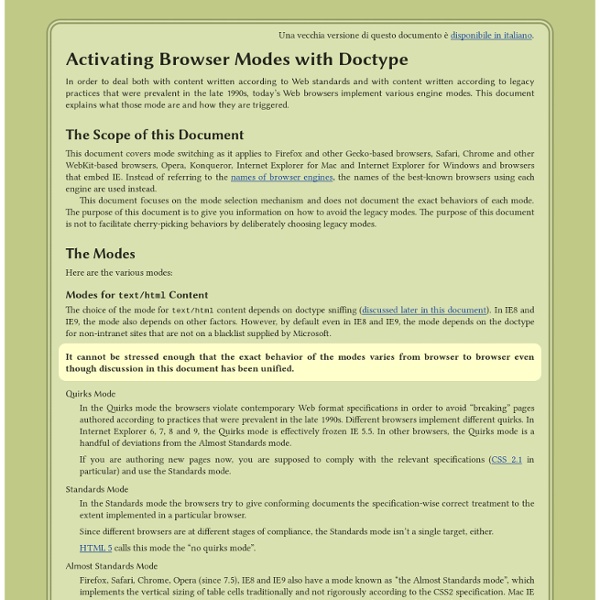Activating Browser Modes with Doctype

Ultimate IE6 Cheatsheet: How To Fix 25+ Internet Explorer 6 Bugs
inShare33 The best strategy for dealing with Internet Explorer 6 is not to support it. Stop. This isn't one of those rants about IE6 or a campaign to try to kill it. I've scoured the web for resources and also included some of my own fixes for IE6 and now I've put it all together in this cheatsheet/reference manual as a resource for anyone who has to deal with Internet Explorer 6. This massive IE6 guide took a while to put together, so bookmark it, share it, tweet it, and use it to save yourself and your coworkers hours of screaming at your monitor and banging your head against your desk or other inanimate objects. Update: Yann Faurie has graciously provided a French translation of this article. Table Of Contents Strategies Before addressing IE6-specific bugs and fixes, it's important to first visit some strategies that will help minimize the occurence of troublesome issues. Contents | Top IE6 Market Share Plan Your Design and Keep It Simple Use A Correct Doctype HTML 4.01 Strict A Simple Reset
Firefox 4: HTML5 Forms
Firefox 4 will come with better support for HTML5 forms. In the latest beta we are experimenting with a set of new features: more inputs types (email, url, tel, search), new attributes (placeholder, autofocus, list), decoupled forms and different validation mechanisms. This is thanks mostly to the hard work of Mounir Lamouri. Some examples will work in other browsers, but you’ll need Firefox 4 beta to see all of them. New input field types In the same fashion as new HTML5 elements, we have new field types to better express what kind of input we want. In this beta, Firefox comes with four new kind of inputs : Of the four new input types, url and email will also validate their content. We also have support for a new kind of field: You can use this element to represent an area of the page that reacts to the interaction with a form. Text fields have been improved with <datalist> support. New input attributes Autofocus When you add this to a field, it will receive focus as soon as possible. url
CSS3 PIE: CSS3 decorations for IE
Related:
Related:



